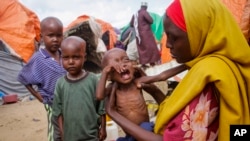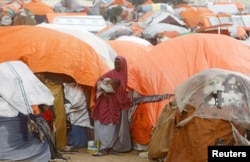The U.N. is appealing for $2.6 billion this year to assist 7.6 million of the most vulnerable Somalis who are facing acute hunger and possible famine from conflict, high food prices, and unprecedented drought.
"Famine is a strong possibility from April to June this year, and of course beyond, if humanitarian assistance is not sustained, and if the April to June rains underperform as currently forecast," Adam Abdelmoula, the U.N. resident and humanitarian coordinator for Somalia, told reporters in a video briefing.
The country, along with other parts of the Horn of Africa, is in the throes of historic drought after five consecutive failed rainy seasons.
Abdelmoula said nearly 6.4 million people are currently facing high levels of food insecurity and that is expected to rise to 8.3 million between April and June, including 727,000 of them who are expected to experience catastrophic hunger levels.
The U.N. says those at highest risk are in Baidoa and Burhakaba districts and among the displaced populations in the Baidoa town of Bay Region and in Mogadishu. In addition, several areas and population groups in central and southern Somalia are at risk of famine.
Abdelmoula said the distinction between a declared famine and what millions of Somalis are already experiencing is "truly meaningless," as children are already starving.
In 2011, after three failed rainy seasons, Somalia went through a famine that killed 250,000 people — half of them children. Now it is in its fifth failed rainy season and the forecast for the upcoming one is not promising.
"Don't listen to those who tell you that this is the worst drought in 40 years," Abdelmoula said. "This is the worst drought in Somalia's recorded history, period."
He urged donors to step up, noting that after the 2011 famine the international community said "never again."
"If we truly want to honor that promise, there is no time to lose," he said. "Every delay in assistance is a matter of life or death for families in need."










